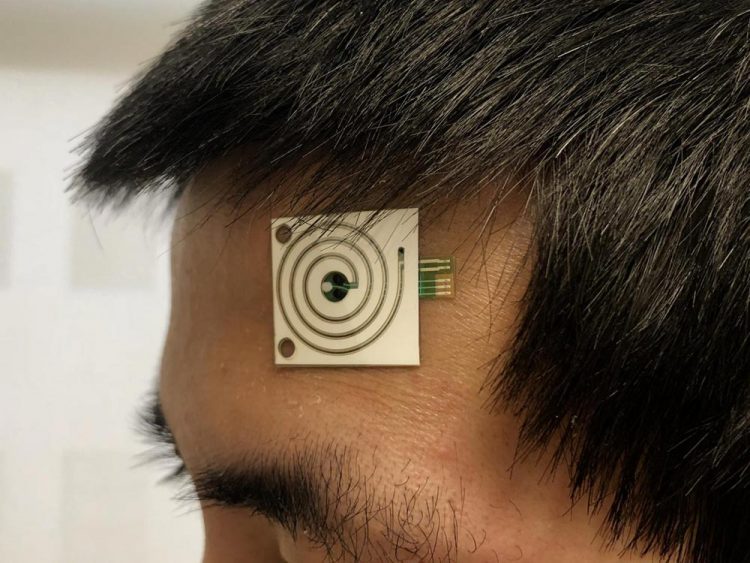Wearable sensors detect what's in your sweat

New wearable sensors developed by scientists at UC Berkeley can provide real-time measurements of sweat rate and electrolytes and metabolites in sweat. Credit: Bizen Maskey, Sunchon National University
Needle pricks not your thing? A team of scientists at the University of California, Berkeley, is developing wearable skin sensors that can detect what's in your sweat.
They hope that one day, monitoring perspiration could bypass the need for more invasive procedures like blood draws, and provide real-time updates on health problems such as dehydration or fatigue.
In a paper appearing today (Friday, August 16) in Science Advances, the team describes a new sensor design that can be rapidly manufactured using a “roll-to-roll” processing technique that essentially prints the sensors onto a sheet of plastic like words on a newspaper.
They used the sensors to monitor the sweat rate, and the electrolytes and metabolites in sweat, from volunteers who were exercising, and others who were experiencing chemically induced perspiration.
“The goal of the project is not just to make the sensors but start to do many subject studies and see what sweat tells us — I always say 'decoding' sweat composition,” said Ali Javey, a professor of electrical engineering and computer science at UC Berkeley and senior author on the paper.
“For that we need sensors that are reliable, reproducible, and that we can fabricate to scale so that we can put multiple sensors in different spots of the body and put them on many subjects,” said Javey, who also serves as a faculty scientist at Lawrence Berkeley National Laboratory.
The new sensors contain a spiraling microscopic tube, or microfluidic, that wicks sweat from the skin. By tracking how fast the sweat moves through the microfluidic, the sensors can report how much a person is sweating, or their sweat rate.
The microfluidics are also outfitted with chemical sensors that can detect concentrations of electrolytes like potassium and sodium, and metabolites like glucose.
Javey and his team worked with researchers at the VTT Technical Research Center of Finland to develop a way to quickly manufacture the sensor patches in a roll-to-roll processing technique similar to screen printing.
“Roll-to-roll processing enables high-volume production of disposable patches at low cost,” Jussi Hiltunen of VTT said. “Academic groups gain significant benefit from roll-to-roll technology when the number of test devices is not limiting the research. Additionally, up-scaled fabrication demonstrates the potential to apply the sweat-sensing concept in practical applications.”
To better understand what sweat can say about the real-time health of the human body, the researchers first placed the sweat sensors on different spots on volunteers' bodies — including the forehead, forearm, underarm and upper back — and measured their sweat rates and the sodium and potassium levels in their sweat while they rode on an exercise bike.
They found that local sweat rate could indicate the body's overall liquid loss during exercise, meaning that tracking sweat rate might be a way to give athletes a heads up when they may be pushing themselves too hard.
“Traditionally what people have done is they would collect sweat from the body for a certain amount of time and then analyze it,” said Hnin Yin Yin Nyein, a graduate student in materials science and engineering at UC Berkeley and one of the lead authors on the paper. “So you couldn't really see the dynamic changes very well with good resolution. Using these wearable devices we can now continuously collect data from different parts of the body, for example to understand how the local sweat loss can estimate whole-body fluid loss.”
They also used the sensors to compare sweat glucose levels and blood glucose levels in healthy and diabetic patients, finding that a single sweat glucose measurement cannot necessarily indicate a person's blood glucose level.
“There's been a lot of hope that non-invasive sweat tests could replace blood-based measurements for diagnosing and monitoring diabetes, but we've shown that there isn't a simple, universal correlation between sweat and blood glucose levels,” said Mallika Bariya, a graduate student in materials science and engineering at UC Berkeley and the other lead author on the paper. “This is important for the community to know, so that going forward we focus on investigating individualized or multi-parameter correlations.”
###
Co-authors on the paper include Liisa Kivimaki, Sanna Uusitalo, Elina Jansson, Tuomas Happonen and Christina Liedert of the VTT Technical Research Center of Finland; and Tiffany Sun Liaw, Christine Heera Ahn, John A. Hangasky, Jianqi Zhao, Yuanjing Lin, Minghan Chao, Yingbo Zhao and Li-Chia Tai of UC Berkeley.
This work was supported by the NSF Nanomanufacturing Systems for Mobile Computing and Mobile Energy Technologies (NASCENT), the Berkeley Sensor and Actuator Center (BSAC), and the Bakar fellowship.
Media Contact
All latest news from the category: Information Technology
Here you can find a summary of innovations in the fields of information and data processing and up-to-date developments on IT equipment and hardware.
This area covers topics such as IT services, IT architectures, IT management and telecommunications.
Newest articles

A new puzzle piece for string theory research
Dr. Ksenia Fedosova from the Cluster of Excellence Mathematics Münster, along with an international research team, has proven a conjecture in string theory that physicists had proposed regarding certain equations….

Climate change can cause stress in herring larvae
The occurrence of multiple stressors undermines the acclimatisation strategies of juvenile herring: If larvae are exposed to several stress factors at the same time, their ability to respond to these…

Making high-yielding rice affordable and sustainable
Plant biologists show how two genes work together to trigger embryo formation in rice. Rice is a staple food crop for more than half the world’s population, but most farmers…



